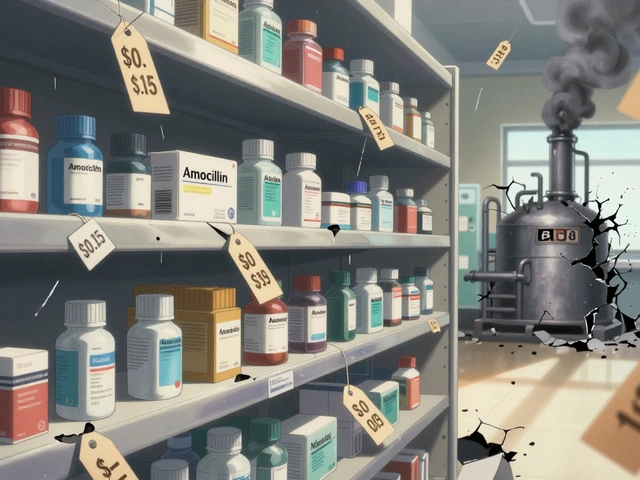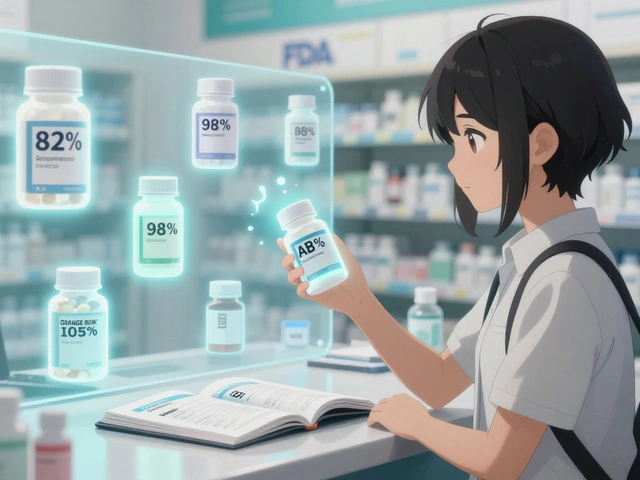Licorice and Medications: Unexpected Interactions with a Common Candy

Most people think of licorice as just a sweet, chewy candy-something you grab at the checkout counter or hand to a kid on Halloween. But if you’re taking any kind of medication, that piece of black licorice might be doing more than satisfying a craving. It could be quietly messing with your blood pressure, your potassium levels, or even the way your drugs work in your body. And you probably have no idea.
What’s Really in Licorice Candy?
Not all licorice is the same. The real deal comes from the root of the Glycyrrhiza glabra plant and contains a compound called glycyrrhizin. That’s the stuff that gives licorice its distinct flavor-and its dangerous side effects. But here’s the catch: a lot of what’s sold as "licorice" in the U.S. doesn’t even contain real licorice. Instead, it’s flavored with anise oil, which tastes similar but has none of the pharmacological effects. You won’t find glycyrrhizin in those products. So if you’re worried about interactions, you need to know what you’re actually eating.Real black licorice candy typically contains 0.5% to 2% glycyrrhizin. That means eating just 50 grams (about 1.7 ounces) of strong licorice candy could give you close to 100 mg of glycyrrhizin-the daily limit recommended by the European Food Safety Authority. And if you’re snacking on it every day? That’s where trouble starts.
How Licorice Messes With Your Body
Glycyrrhizin acts like a fake hormone. It blocks an enzyme in your kidneys called 11β-hydroxysteroid dehydrogenase type 2. Normally, this enzyme keeps cortisol (your stress hormone) from overstimulating mineralocorticoid receptors. When it’s blocked, cortisol starts acting like aldosterone-the hormone that tells your body to hold onto salt and pee out potassium.The result? Your body holds onto water, your blood pressure spikes, and your potassium levels drop. This is called pseudoaldosteronism. Symptoms include headaches, fatigue, muscle weakness, swelling in your legs, and in severe cases, irregular heartbeat or even heart failure. One case study in 2012 showed a man who ate 200 grams of licorice daily for three weeks ended up with a blood pressure of 210/120 and a potassium level of 2.6 mmol/L-dangerously low. Normal is 3.5 to 5.0.
It doesn’t take a candy bar a day to cause this. People have reported serious side effects after eating just 30 grams of licorice daily for a few days. And if you’re already on medication that affects your blood pressure or potassium? You’re playing with fire.
Medications That Can Turn Licorice Into a Health Risk
Here’s the real danger zone: licorice doesn’t just cause problems on its own. It makes certain medications way more dangerous-or less effective.- Diuretics (water pills): Thiazides and loop diuretics like furosemide already make you lose potassium. Add licorice, and your potassium can crash to life-threatening levels. One patient in a 2023 report dropped below 3.0 mmol/L after combining lisinopril and licorice.
- Antihypertensives: If you’re on blood pressure meds like ACE inhibitors or beta-blockers, licorice can undo their work. One man taking fludrocortisone (a steroid that raises blood pressure) saw his BP jump to 205/110 after eating licorice-even though his dose hadn’t changed.
- Warfarin and other blood thinners: Licorice can either increase or decrease their effect. Some studies show it boosts warfarin’s action, raising your INR and bleeding risk. Others show it lowers INR, making the drug less effective. Either way, your clotting levels become unpredictable.
- Digoxin: This heart medication is tricky. Low potassium makes your body more sensitive to digoxin. A single case report linked licorice-induced hypokalemia to digoxin toxicity, which can cause nausea, confusion, and dangerous heart rhythms.
- Metformin: Animal studies suggest licorice might reduce metformin’s effectiveness in lowering blood sugar. While human data is limited, it’s a red flag for people with diabetes.
The worst part? Many people don’t realize they’re taking a drug that interacts with licorice. A 2021 survey found that only 37% of community pharmacists could list all the major interactions. If your pharmacist doesn’t know, how would you?

Not All Licorice Is Created Equal
There’s a big difference between what’s on the shelf:- Traditional black licorice candy: Contains glycyrrhizin. High risk if eaten regularly.
- Anise-flavored "licorice": No glycyrrhizin. Safe for most people on meds.
- Deglycyrrhizinated licorice (DGL): Glycyrrhizin removed. Used for stomach issues like ulcers. No blood pressure risk.
- Licorice supplements: Often contain 4-24% glycyrrhizin. Much more potent than candy. High risk.
Labels rarely tell you how much glycyrrhizin is in a product. A 2023 Consumer Reports survey found that 78% of black licorice products didn’t list glycyrrhizin content. And 92% didn’t warn about drug interactions. You’re guessing. And that’s not safe.
Who’s at Highest Risk?
It’s not just about how much you eat. Some people are more sensitive:- People over 60
- Those with existing high blood pressure
- Anyone with heart or kidney disease
- People taking multiple medications
- Women on birth control or hormone therapy (estrogen may increase sensitivity)
Even healthy adults can develop problems after just two to four weeks of daily licorice consumption. One Reddit user reported his blood pressure jumped from 120/80 to 165/95 after eating 30 grams a day for three days. He stopped the candy, and his BP returned to normal in a week.
What Should You Do?
If you’re on any of the medications listed above, here’s what you need to do:- Check your candy. Look for "real licorice" or "Glycyrrhiza glabra" on the ingredient list. If it just says "anise flavor," you’re probably safe.
- Stop eating black licorice. If you’re on blood pressure meds, diuretics, or heart meds, avoid it entirely.
- Ask your doctor or pharmacist. Don’t assume they know. Bring up licorice specifically-even if you think it’s harmless.
- Monitor your symptoms. If you’ve been eating licorice and suddenly feel fatigued, swollen, or dizzy, stop immediately and get your potassium and blood pressure checked.
- Choose DGL if you need licorice for health reasons. It’s available as chewable tablets for acid reflux or ulcers. It won’t raise your blood pressure.
The FDA doesn’t set a daily limit, but the European standard of 100 mg glycyrrhizin per day is a good guideline. That’s about one small bag of licorice candy. And even that’s too much if you’re on meds.
Why This Isn’t Common Knowledge
The licorice industry is worth over $1.3 billion globally. Most of it is sold as candy, not medicine. So there’s little incentive to warn people. The FDA classifies it as "Generally Recognized As Safe"-but that’s based on short-term use in healthy adults. It doesn’t account for long-term use with medications.Meanwhile, regulatory agencies in the UK and Japan now require warning labels on high-glycyrrhizin products. The European Commission is even considering reclassifying licorice supplements as medicines. In the U.S.? Still no labels. No warnings. Just a sweet treat on the shelf.
That’s why the burden falls on you. If you’re taking medication, assume licorice is risky until proven otherwise. And if you’re not sure? Skip it. Your body will thank you.
Can I eat licorice if I’m on blood pressure medication?
No, it’s not safe. Licorice contains glycyrrhizin, which causes your body to retain sodium and lose potassium-both of which raise blood pressure. If you’re on ACE inhibitors, beta-blockers, or diuretics, licorice can undo their effects and lead to dangerous spikes in blood pressure or dangerously low potassium levels. Even small amounts consumed daily for a few weeks can cause problems.
Is anise-flavored candy the same as licorice?
No. Anise-flavored candy tastes similar but contains no glycyrrhizin, the compound in real licorice root that causes drug interactions and side effects. If the ingredient list says "anise oil" or "natural flavor" without mentioning licorice root, it’s generally safe. But always check-many products mix real licorice with anise and don’t make it clear.
What is DGL licorice, and is it safe?
DGL stands for deglycyrrhizinated licorice. It’s a form of licorice where the glycyrrhizin has been removed. It’s used to treat stomach ulcers and acid reflux because it retains some healing properties without the blood pressure risks. DGL is safe for people on blood pressure or heart medications, as long as it’s truly deglycyrrhizinated (check the label for less than 1% glycyrrhizin).
How much licorice is too much?
The European Food Safety Authority says 100 mg of glycyrrhizin per day is the safe upper limit for healthy adults. That’s roughly 50 grams (about 1.7 ounces) of traditional black licorice candy. But if you’re on medications like diuretics, blood thinners, or heart drugs, even half that amount daily for more than a week can be risky. There’s no safe amount for people on these meds-avoid it completely.
Can licorice affect my potassium levels?
Yes, significantly. Glycyrrhizin in licorice causes your kidneys to flush out potassium and hold onto sodium. This can lead to hypokalemia (low potassium), which causes muscle weakness, cramps, fatigue, and irregular heartbeat. In extreme cases, it can trigger dangerous heart rhythms or even cardiac arrest. People on diuretics or with kidney disease are at highest risk.
Should I stop licorice if I’m taking warfarin?
Yes. Licorice can interfere with warfarin in unpredictable ways. Some studies show it increases warfarin’s effect, raising your INR and bleeding risk. Others show it decreases the effect, making your blood clot too easily. Either way, your INR becomes unstable. If you’re on warfarin, avoid licorice entirely and tell your doctor if you’ve been eating it.
Are licorice supplements more dangerous than candy?
Much more dangerous. Licorice supplements often contain 4-24% glycyrrhizin, compared to 0.5-2% in candy. A single capsule might deliver more glycyrrhizin than an entire bag of candy. They’re also rarely labeled with warnings. People taking supplements for "digestive health" or "immune support" are often unaware they’re risking serious drug interactions.
What to Do Next
If you’ve been eating licorice and are on medication, don’t panic-but don’t ignore it either. Stop consuming real licorice immediately. Keep track of any symptoms: headaches, swelling, fatigue, muscle cramps, or irregular heartbeat. Schedule a quick blood test to check your potassium and blood pressure. Tell your doctor what you’ve been eating-even if you think it’s harmless.And next time you’re tempted to grab a bag of black licorice? Ask yourself: Is this candy worth risking my health? The answer might surprise you.






Brierly Davis
November 6, 2025 AT 22:40Yikes, I had no idea licorice could mess with my blood pressure like that. I eat that stuff like candy every week. Guess I’m switching to the anise-flavored stuff now. Thanks for the heads-up - this might’ve saved me a trip to the ER.
Also, DGL sounds like a legit alternative if you still want that licorice taste. I’ll grab some for my acid reflux. Win-win.
Amber O'Sullivan
November 7, 2025 AT 07:45So let me get this straight people are dying because they thought candy was harmless and no one warned them
the system is broken
Jim Oliver
November 7, 2025 AT 10:49Wow. Just… wow. Someone actually wrote a 2000-word essay on licorice and didn’t mention that the FDA doesn’t regulate it because it’s classified as a ‘food’ - not a drug - despite being pharmacologically active.
And you’re shocked? This is capitalism 101. If it’s profitable, they’ll sell it. If it kills you slowly? That’s just ‘unforeseen side effects.’
Also, ‘DGL’? That’s not a product - it’s a loophole. Don’t be fooled.
William Priest
November 9, 2025 AT 02:45so like… if you’re on meds and you eat licorice… you’re basically a dumbass?
not even joking. i’ve seen people take melatonin with alcohol and wonder why they’re passed out. same energy here. read the label. it’s not that hard. if it says ‘licorice root’ - put it back. done.
also why is this even a thing? it’s just candy. why are we treating it like a prescription?
Ryan Masuga
November 9, 2025 AT 12:51Big thanks for laying this out so clearly - I’ve been on lisinopril for years and had no clue. I even bought that black licorice bag last week thinking it was just ‘flavor.’
Just tossed it. No regrets. Also, I asked my pharmacist about it yesterday and she looked at me like I’d asked if gravity was real. So yeah - don’t assume they know. Ask. Even if it feels dumb.
And if you’re on meds? Treat licorice like it’s poison. Because honestly? It kinda is.
Jennifer Bedrosian
November 11, 2025 AT 05:24OMG I JUST REALIZED I’VE BEEN EATING BLACK LICORICE EVERY DAY FOR A MONTH BECAUSE I THOUGHT IT WAS ‘HEALTHY’ BECAUSE IT’S NATURAL
MY LEGS HAVE BEEN SWOLLEN AND I’VE BEEN SO TIRED I THOUGHT IT WAS JUST ‘AGING’
I’M GOING TO THE DR. NOW. I HOPE I’M NOT DEAD.
IF YOU’RE READING THIS AND EATING LICORICE WITH BP MEDS - STOP. RIGHT NOW. I’M SCARED FOR YOU.
also i’m crying now. i feel betrayed by candy
Lashonda Rene
November 12, 2025 AT 05:48you know i think a lot of people dont realize how sneaky these things are like we think if its natural or if its candy then it cant hurt but the truth is like the body doesnt care if its from a plant or a lab if it changes how your hormones work its still a big deal
and i think the worst part is that companies dont have to tell you because its not a drug so you just keep buying it and eating it and thinking youre fine until your potassium drops and you cant even stand up
and then you go to the doctor and they ask you what you eat and you say oh just candy and they look at you like you’re crazy
so i guess the lesson is dont trust anything that tastes good unless you know exactly what’s in it
Andy Slack
November 12, 2025 AT 23:44Just stopped eating licorice. Period.
My dad had a stroke at 62. I’m not taking chances.
Also - DGL is the real MVP. Got some for my stomach. Tastes fine. No drama.
Stay safe out there.